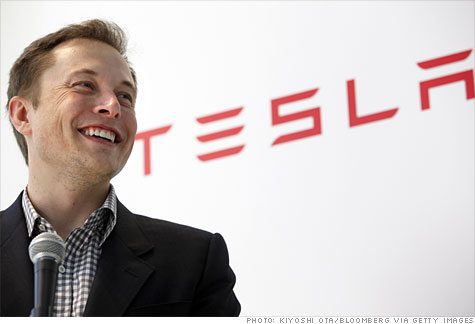California-based electric vehicle maker Telsa Motors has announced details of its much-touted plans to build a $5 billion battery “Gigafactory,” in a move that will see the prestige EV maker become a major force in both US manufacturing and electric power.
The large-scale battery plant, which Telsa co-founder and CEO Elon Musk is billing as the world’s biggest, is expected to produce more lithium-ion batteries than the entire global supply for 2013 – enough to power 500,000 electric vehicles annually. It will also help accelerate the cost reduction of battery storage, in turning creating a pathway for a rapid transformation of the world’s biggest electricity markets.
Tesla announced the gigafactory plans and fundraising details on Wednesday, after its shares closed at their highest since the company’s IPO in June 2010. It is now worth more than half of industry giant GM.
The EV maker said it would invest about $2 billion in the plant – funds it would raise through the sale of at least $1.6 billion of convertible notes – while as yet unnamed partners (although likely to include Panasonic which has reportedly been raising funds for this purpose) would invest up to another $3 billion. The location of the plant, somewhere in the American south west, is undecided.
It’s another typically audacious move from Tesla CEO and co-founder, Elon Musk, which some are predicting will shake up America’s power industry and perhaps even trigger a bidding contest between states eager for the jobs and investment.
As David Unger writes in the Christian Science Monitor, Tesla “has always blurred the lines between the energy, technology, and automotive industries.” But with its proposed battery gigafactory, and stronger ties with Musk’s solar energy firm SolarCity, it aims to capitalise on the links between power, transportation, and innovation.
“Portable energy is the next big thing,” Karl Brauer, senior analyst at Kelley Blue Book, said in an interview with Unger. “If we can master it in the modern era – if we can make it cheaper and more effective – it’s going to make our lives easier. There’s a huge long-term corporate play there. Elon Musk needs batteries for Tesla, but he can also use them to influence a lot of other industries.”
As Bloomberg notes, however, the key role of the plant is key to Tesla becoming a mass-market automaker capable of producing 500,000 or more EVs a year from a projected.
“With this facility, we feel highly confident of being able to create a compelling and affordable electric car in approximately three years,” Elon Musk, Tesla’s chief executive, and Deepak Ahuja, its chief financial officer, wrote in a report last week.
The automaker expects to reduce the per-kilowatt cost of its battery packs by more than 30 percent by the end of the first year of volume production for its third-generation electric vehicle, thereby also reducing significant supply-chain risk. That would bring the cost of its first mass-market EV, which is expected to travel 320kms 2 on a single charge , down to a price of around $35,000.
Tesla’s battery costs are estimated to be slightly lower than the industry average of around $400/kWh, but Tesla is aiming to reduce this to below $200/kWh and possible as low as $150/kWh by 2020. At that price, analysts say, the batteries are so relatively inexpensive that they become affordable as backup power supplies to the electric-power industry.
Having control over battery production is valuable to an electric-car company because it’s the single most important component,” Brauer says. “When you aren’t building your own batteries you’re at the mercy of your suppliers.”
Tesla says its Gigafactory will also be ‘green’; powered largely by solar power and wind energy. It is expected to employ 6,500 workers.
But it will have a huge impact beyond Tesla, says Harley Shaiken, a labor economist at the University of California. “It gives enormous legitimacy to battery production and the future of the electric car because that lies in the battery,” Shaiken told Bloomberg. “It’s high stakes, high technology.”
For Musk, it could get him closer to his stated goal of being a leader in America’s power-storage industry, as US households and businesses turn to batteries and solar PV to reduce electricity bills.
“The applications for these battery systems include backup power, peak demand reduction, demand response and wholesale electric market services,” Tesla said in a regulatory filing Wednesday. “We plan to ramp sales of these products in 2014.”
According to Bloomberg, Musk last week tipped Panasonic – currently the biggest supplier of lithium-ion cells used in Tesla car batteries – may also be involved. But he stressed that Panasonic’s participation was “not 100 percent confirmed.”










